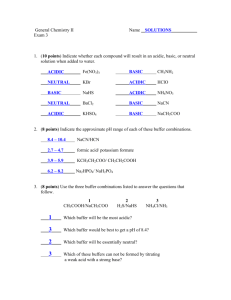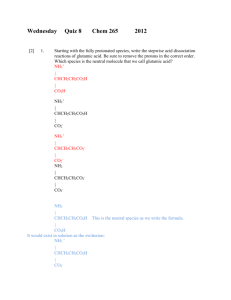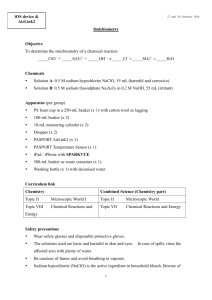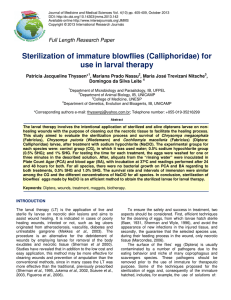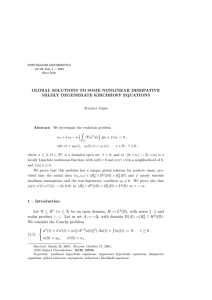PPT 2 - Teach.Chem
advertisement
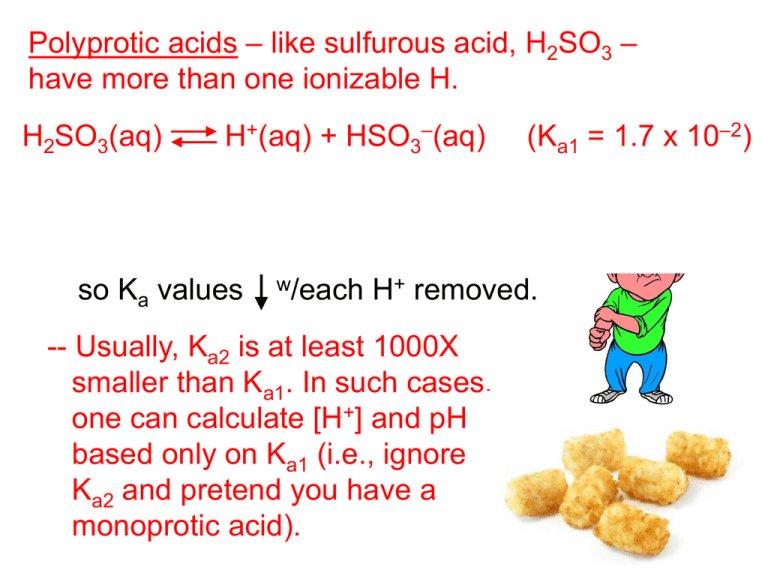
Polyprotic acids – like sulfurous acid, H2SO3 – have more than one ionizable H. H2SO3(aq) H+(aq) + HSO3–(aq) (Ka1 = 1.7 x 10–2) HSO3–(aq) H+(aq) + SO32–(aq) (Ka2 = 6.4 x 10–8) -- It is harder to remove additional H+s, so Ka values w/each H+ removed. -- Usually, Ka2 is at least 1000X smaller than Ka1. In such cases, one can calculate [H+] and pH based only on Ka1 (i.e., ignore Ka2 and pretend you have a monoprotic acid). Find the pH of a 0.0037 M carbonic acid solution. (Ka1 = 4.3 x 10–7, Ka2 = 5.6 x 10–11) H+(aq) + HCO3–(aq) H2CO3(aq) at eq. [ ] 0.0037 – x 2 x 4.3 x 10–7 = 0.0037 – x x shortcut x 2 x 4.3 x 10–7 = 0.0037 x = [H+] = 3.97 x 10–5 M x = [H+] = 3.99 x 10–5 M pH = 4.40 pH = 4.40 ([H+] after 1st ionization = 3.97 x 10–5 M) HCO3–(aq) at eq. [ ] 3.97 x 10–5 – y H+(aq) + CO32–(aq) 3.97 x 10–5 + y y –5 + y) (y) (3.97 x 10 5.6 x 10–11 = 3.97 x 10–5 – y –5y + y2) (3.97 x 10 5.6 x 10–11 = 3.97 x 10–5 – y y = add’l [H+] = 5.6 x 10–11 M pH = 4.40 totally negligible Weak Bases (i.e., proton acceptors) weak base + H2O conjugate acid + OH– [conj. acid] [OH–] Kb = [weak base] Weak bases are often nitrogencontaining molecules (“amines”) or anions. (all of these have lone e– pairs) dimethylamine Example: + H–N–CH3(aq) + H2O(l) H–N–CH3 (aq) + OH–(aq) H H H : [ ] What is the conc. of ammonia in a solution of pH 9.35? Ammonia’s Kb = 1.8 x 10–5. Since pOH = 4.65, [OH–] = 10–4.65 = 2.24 x 10–5 M. NH4+(aq) + OH–(aq) NH3(aq) + H2O(l) x – 2.24 x 10–5 w.c? 2.24 x 10–5 –5)2 (2.24 x 10 1.8 x 10–5 = x – 2.24 x 10–5 x = [NH3]init. = 5.0 x 10–5 M 2.24 x 10–5 Anions related to Weak Acids NaClO(aq) Na+(aq) + ClO–(aq) This is the conj. base of HClO, so it acts as a weak base in H2O (i.e., it accepts H+). ClO–(aq) + H2O(l) Sodium hypochlorite is the active ingredient in bleach, which is used as a laundry additive and to disinfect water for swimming pools. HClO(aq) + OH–(aq) What mass of NaClO is required to make 2.0 L of a pH 10.50 solution? The Kb for ClO– is 3.3 x 10–7. Since pOH = 3.50, [OH–] = 10–3.50 = 3.16 x 10–4 M. ClO–(aq) + H2O(l) HClO(aq) + OH–(aq) x – 3.16 x 10–4 w.c? 3.16 x 10–4 [HClO] [OH–] Kb = [ClO–] mol NaClO M NaClO = L soln 0.3029 M 2.0 L –4)2 (3.16 x 10 3.3 x 10–7 = x – 3.16 x 10–4 x = [ClO–]init. = [NaClO]init. = 0.3029 M 3.16 x 10–4 0.6058 mol NaClO 45 g NaClO

